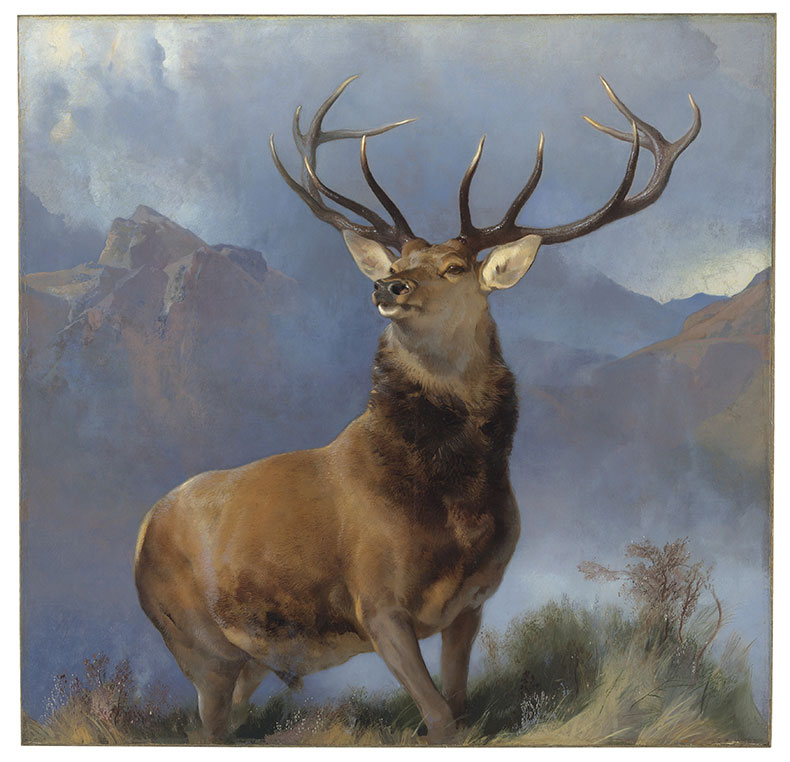At the end of September, the new Scottish galleries at the National in Edinburgh (the old National Gallery of Scotland) opened to the public. The £38.6m renovation, funded by the Scottish Government and the National Lottery Heritage Fund with substantial donations from trusts, foundations and private individuals, represents the most substantial building project on the Mound since the 1970s. An entirely new suite of galleries offers twice the space to display Scottish art, replacing and extending the dingy mix of small galleries and offices that were once tucked beneath the splendid neoclassical William Henry Playfair building above. Wide walkways provide better access to the galleries while the additional wall space and enhanced lift access have enabled curators to hang large pictures that were long relegated to storage.
The Monarch of the Glen (c. 1851), Sir Edwin Landseer. National Galleries of Scotland

Visitors will now not reach The Monarch of the Glen (1851), Sir Edward Landseer’s famously romantic personification of Scotland’s majesty, until the end of the sweeping ground-floor circuit. Instead, this first survey of pictures dating from 1800 to 1945 from the combined collections of the National Galleries of Scotland begins with Anne Redpath’s vivid, Matisse-influenced The Indian Rug (or Red Slippers) (1942). A generation younger than the Scottish Colourists, Redpath was a much-travelled cosmopolitan whose sophisticated response to international modern trends sets the interpretative direction of the whole display.
The wide spaces provide more wall space and improved accessibility. Photo: Campbell Donaldson/Ralia Media

Once through the double doors, visitors are met by other mid 20th-century masterpieces that assert the outward-looking ambition and achievement of Scottish painting. There is a large, richly coloured abstract painting titled A Point in Time (1929–37) by William Johnstone, one of the first British artists to turn definitively from figuration to abstraction. The work combines influences from Johnstone’s travels: the Surrealism he encountered in Paris in the 1920s, cave art on the Iberian Peninsula and Native American sand paintings in California, with his interest in the Pictish and Celtic art of Scotland. Another powerful work is Cecile Walton’s ironic response to Manet’s Olympia, from 1920. Romance depicts the artist herself lying half-clothed in a bedsheet staring interrogatively at her newborn baby Edward while her five-year-old son Gavril looks on. A broken rose lies scattered on the wooden floor. Walton’s marriage to fellow Edinburgh art student Eric Harald Macbeth Robertson was really over by 1923, as was her career as a painter. From 1927, when the couple officially divorced, she had to pursue other careers, as a writer, set painter and radio broadcaster, to sustain her small family.
The Sailing of the Emigrant Ship (1895), William McTaggart. National Galleries of Scotland.

The suspension of activity during the years of renovation has allowed time for an extensive curatorial reappraisal of the National Galleries of Scotland’s holdings. The result is a thematic display, which underlines the strength of Scottish painting across genres ranging from history painting, paintings inspired by literature (especially Sir Walter Scott), portraiture and photography to landscape. Besides the mythologising epic landscapes of the Victorian era, which are hanging in the final ground floor gallery, the new space has enabled curators to display a large number of works by William McTaggart (1835–1910). Rather than focusing attention on a single iconic piece, we experience in depth the range of his passionate, Impressionist-influenced response to Scottish history, seas and landscapes – his figures tangled in the storms and blown grasses he evokes. We also encounter the work of Charles Rennie Mackintosh, through a muscular watercolour of a landscape near Mont Alba in the French Pyrenees, and of James Macintosh Patrick, through the superb small oil painting, Stobo Kirk, from 1939, setting rectilinear buildings, echoed by loose hay stooks, against a rounded hillside and dramatic sky. There is also a reminder of the strong tradition of decorative arts in Scotland, with a room of symbolist embroideries by Phoebe Anna Traquair (1852–1936) and the newly-restored screen The King’s Quair (1867–68) by William Bell Scott, a little-known Pre-Raphaelite.
The Progress of a Soul: The Entrance (1895), Phoebe Anna Traquair. National Galleries of Scotland.

As you would hope, there are paintings by Celtic revivalists, the leading Colourists, the Glasgow Boys and Girls and, powerfully presented on either side of new windows looking on to the famous view of the Scott Monument and the Waverley Station, paintings of Edinburgh by Alexander Nasmyth (1758–1840), photographs by David Octavius Hill (1802–70) and Robert Adamson (1821–28), which record the magnificent city as it is being built.
When the National Gallery of Scotland first opened in 1859, national pride was embodied in splendid collections of foreign art – Italian, Flemish, French – which were meant to inspire future generations of artists. Now we see unfolded the still-continuing drama of Scotland’s own distinctive artistic tradition, in dialogue with the world.
The Scottish Galleries are now open at the National, Edinburgh.


